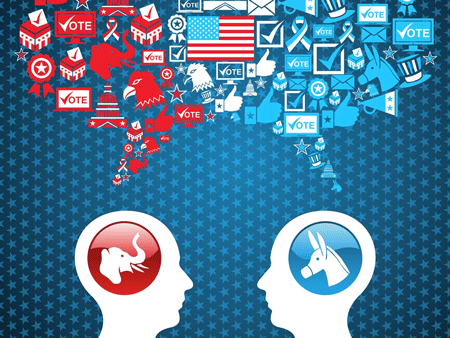The Roaring 2020s
In these dark first weeks of 2021, the cycles of history make a case for optimism. Center Director Jeffrey Cole explores what we can learn from the 1920s and the 1820s.
By Jeffrey Cole
Between the catastrophic storming of the U.S. Capitol and record levels of infection, hospitalization, and death from the coronavirus, 2021 is off to a bad start. Fortunately, with the ramping up of vaccinations and the inauguration of a new President, hopeful resolution of both crises is within sight.
Then what?
The year-old decade of the 2020s is just the third 20s decade in American history. There may well be some important parallels from 100 years ago in the 1920s. If we are lucky and all our stars align, there may also be some parallels from the 1820s.
Two of our great American historians, Arthur Schlesinger and his son Arthur Schlesinger Jr., long ago crafted a model to explain actions and reactions in American history. In Schlesinger Jr.’s book, The Cycles of American History, he explores how certain patterns repeat and then ultimately generate a polar opposite reaction.
A strong case can be made that the 2020s may well share many patterns from the 1920s.
The 1920s are better known as the “Roaring Twenties.” The Twenties began as America emerged from two calamitous events that shook the foundations of society and produced mass casualties: World War I and the Spanish Flu.
After so much suffering, people wanted to enjoy their lives. Warren G. Harding spent most of the 1920 presidential campaign without leaving his Ohio front porch. He was elected in a landslide by promising that after all the pain and disruption he would bring a “return to normalcy.”
That could be the slogan of any politician today.
In the Roaring Twenties, people responded to the events of the years before by celebrating. It was the age of jazz and flappers as well as frenetic dance crazes like the Charleston. The 1920s was when automobiles, airplanes, movies, radio, and telephones reached the masses.
Millions thought life couldn’t possibly get any better.
It was also an era of massive excess. Although the “noble experiment” of prohibition had begun in 1920, the law was routinely flouted by the illegal production and distribution of alcohol to illegal bars (speakeasys). Along with jazz and cars and radio came gangsters such as Al Capone and events like the St. Valentine’s Day Massacre.
The great authors of the 1920s—Hemingway, Fitzgerald, and Stein among others—wrote stories about the joys of life describing parties, wealth, and privilege. Of course, the joy and celebration were not enjoyed by everyone. While women had just gained the vote, blacks and other minorities remained disenfranchised, suffering immense discrimination. The 1920s was also an era of lynching, riots, and crushing poverty.
Perhaps the biggest symbol of the Roaring Twenties that fueled all its excesses was a booming stock market that rose over 250% during the decade. Average citizens bought stocks for the first time. Believing the market could only go up, many borrowed heavily to buy on margin in order to get in on the adrenalin rush of the boom.
All the exuberance came to a quick end when the stock market crashed in the final three months of 1929 beginning the Great Depression.
Today, as we begin to come out of the Coronavirus pandemic, all we want is a return to normalcy.
The Roaring 2020s are about to begin
 As, we hope, vaccinations first control and then contain the virus, we will feel like we have been paroled from prison. Our first reaction will be to celebrate, probably to excess.
As, we hope, vaccinations first control and then contain the virus, we will feel like we have been paroled from prison. Our first reaction will be to celebrate, probably to excess.
Many will want to buy new clothes (for the first time in a year), dress up, go to parties, and rejoice around other people. Look for elegant balls and formal celebrations, even tuxedos and gowns, to make a quick return. If the Academy Awards survive the pandemic, in 2022 we’ll see a red carpet unlike any other. Theme parks and concerts should see record levels of success.
While many who have a choice have moved out of cities to less dense suburbs where they felt safer, look for a return to big cities and all the activities that happen there. Sports, stage performances, museums, orchestras, and shopping on crowded streets will be an irresistible draw.
To the Roaring 2020s will come the feeling that life is especially precious and can be derailed with little or no warning. We will never want to lose a year of our lives again.
With a little luck, the Roaring 2020s will end better than the Roaring Twenties.
Now, let’s look at the 1820s
The period before the 1820s was marked by the War of 1812, when America was invaded and Washington pillaged. It was also the era of the most virulent partisanship in our history (except, perhaps, for now) between the Federalists and Democrats.
These eerie parallels make a good case for Schlesinger’s cycles of history. Although there was no social media, political lies (known as calumnies) and bitterness spread through the mass medium of the day: newspapers.
The year-old decade of the 2020s is just the third 20s decade in American history. There may well be some important parallels from 100 years ago in the 1920s. If we are lucky and all our stars align, there may also be some parallels from the 1820s.
The election of James Monroe in 1816 saw the end of the war and the collapse of the Federalist Party. The new President wanted to restore national unity and worked hard to avoid partisan nominations to his government. There was even the hope that political parties could be eliminated.
The era of Monroe (1816-1824) has become known as The Era of Good Feelings.
Today such a thing doesn’t seem in the realm of possibility. Of course, it was not good feelings for everyone: slavery thrived, and women were without rights.
I am not predicting that the 2020s will become a new Era of Good Feelings. The much better bet is for partisanship and division to continue or worsen. But a case can be made that such a repeat cycle is possible.
The case for hope
In my optimistic view, Americans feel that our relations with each other have gotten as bad as they can, short of another civil war. The new president talks constantly of healing and reaching out to the other side. His nominations of experienced and centrist people reflect the diversity of America.
In our surveys last year, large majorities of Americans say that coming out of COVID they want to focus on relationships and that they value people and experiences more than physical goods. They speak of a desire to be more charitable and spiritual, and they want to focus on helping others.
Of course, they may quickly forget all these resolutions, but what if the pandemic really did change us? What if we remember COVID the way the people who lived through it remember the Great Depression?
For the first time in 150 years, we may see an alignment of political parties as one of the parties may be reorganized or even eliminated and replaced with a less radical one.
That may not be possible in an era of fake news and social media, but for the first time Twitter banned for life a social media abuser with 80 million followers. What if the tech companies actually policed their users and refused a platform to those filled with hate and untruth?
Naïve? Yes. But it is also possible.
Last week, Senator Lindsay Graham summed up the entire national mood when—even though he has been one of Trump’s most fervent supporters—he could take no more. “Enough is enough!” he screamed.
Rather than taking all our anger and frustration on each other, it is possible that we might collectively work to make our country and lives better. Another Era of Good Feelings is possible.
Just look at our history.
____________

Jeffrey Cole is the founder and director of The Center for the Digital Future at USC Annenberg.
See all columns from the center.
January 13, 2021

